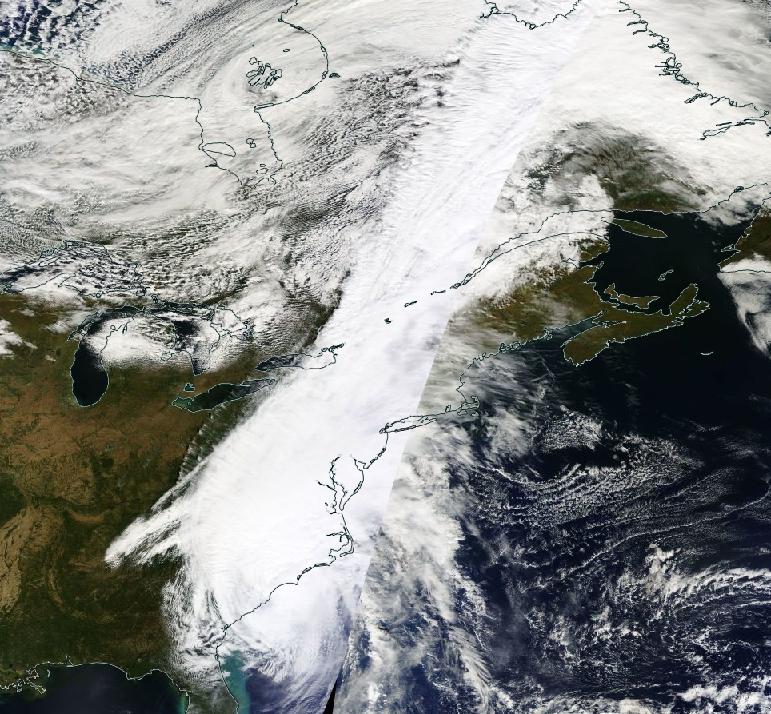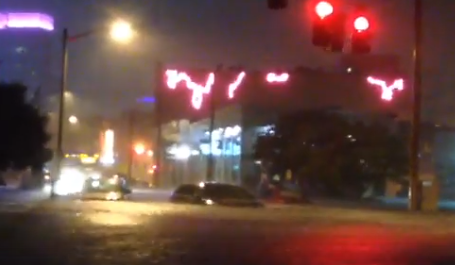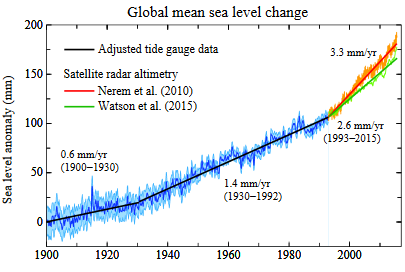Yes, Climate Change Helped Matthew Produce a Massive Swath of Destruction Extending From Haiti to Southeastern Virginia
11
October, 2016
Too
close to home.
That’s the sentence that best describes hurricane Matthew’s
impacts — at least for this particular observer. And it’s one
that I think we will be saying more and more often over the coming
years as sea levels rise and peak storm intensities continue to
increase due to a human-forced warming of the world’s atmosphere
and oceans.
(Hurricane
Matthew interacted with a trough to dump 1 in 1000 year rains over
North Carolina and Virginia on October 8th even as its powerful storm
surge continued to flood coastal communities. Image source: LANCE
MODIS.)
Severe
Damage To Florida Coastline Communities — But it Could Have Been
Worse
On
Thursday, October 6th, as the storm was barreling in toward the
Florida coastline, I was on the phone with numerous Florida relatives
— somewhat frantically asking if they’d heeded evacuation orders
and gotten away from low-lying areas near the ocean. One uncle had
decided to hunker down in an inlet-side New Smyrna Beach home about 6
feet above sea level, but the rest had headed inland. Thankfully,
Matthew passed just off shore of New Smyrna at low tide — only
giving my uncle a bit of a scare by flooding his neighborhood but not
completely inundating his house (as would have happened if Matthew
had made landfall in that community as a category 4 storm rather than
remaining at sea).
Further
north, my college town of St. Augustine, FL did not fair quite so
well. Downtown St. Augustine, which borders the Matanzas River — an
estuary of the Atlantic Ocean — saw Matthew sweeping by at high
tide. As
a result, severe storm surge flooding rose up over the sea wall and
put the city’s streets under 3-4 feet of water.
Local businesses flooded, a 17th Century Fort that is a tourist
attraction saw its moat fill and then overtop, and Flagler College,
which I attended during the 1990s, had its grounds soaked. Nearby,
parts of Route A1A on Flagler Beach were swept out into the Atlantic
Ocean even as the dune line at Jacksonville Beach was breached —
precipitating significant tidal flooding through parts of that
seaside city. But as with New Smyrna Beach, the situation would have
been far worse for St. Augustine and Jacksonville if Matthew had made
landfall and not remained off shore.
Matthew
Delivers Severe Flooding to Georgia, South Carolina, North Carolina
and Virginia
As
the storm passed just to the east of North Florida on October 7th,
consensus model guidance at the time suggested that Matthew would
re-curve out to sea after battering Florida, Georgia, South Carolina
and North Carolina, returning for a possible second hit to Florida by
about the 13th as a much weakened system. However, Matthew instead
took a more northerly track — hugging the coastline. As a result,
moderate to severe coastal flooding impacted beach after beach from
Georgia and on through South Carolina, North Carolina and Virginia
even as heavy rains inundated the region.
(Matthew
pushes storm surge flooding into Murrells Inlet — inundating local
communities and swamping this marina. Video source: Huge
Storm Surge Follows Hurricane Matthew.)
At
Murrells Inlet — a late-summer and early fall reunion and
beach-going spot for my family — over-wash from the ocean and tidal
flooding from the local inlet pushed 1-2 feet of water into numerous
neighborhoods. A local marina from which family members have enjoyed
both the scenic view of the inlet and such water activities as
kayaking through the teeming waterways to experience close-up
encounters with local fish and wildlife was completely flooded out on
the 8th of October as Matthew passed (see video above).
Meanwhile,
severe flooding rains were just starting to sweep into North Carolina
on the 8th and 9th — presenting a serious problem even as coastal
communities along the Outer Banks received a significant battering. A
large swath of the state saw up to 16 inches of rain fall. These
rains hit regions already saturated by previous extreme rainfall
events. As a result, water-logged grounds could not take in any more
precipitation and rainfall runoff swiftly flooded streets and
streams. The flooding has, by early Tuesday afternoon, left
14 people dead, three people missing, and thousands of homes
inundated by rising waters.
A severe flood situation that is still ongoing as of October 12th.
North Carolina Governor Pat McCrorystated
earlier today that:
“Too many people have died, and we don’t want anymore to die. Yet
there are going to be conditions during the next 72 hours which will
be extremely dangerous.”
(Hundreds
of vehicles, homes and businesses were flooded across Hampton Roads
as a result of Matthew’s severe storm surge and heavy rainfall. The
region has grown particularly vulnerable during recent years due to
sea level rise — which has added about 1.5 feet of water rise over
the past 100 years and could add another 2-3 feet or more by
mid-Century under a business as usual fossil fuel burning emissions
path. Image source: Hurricane
Matthew Causes Widespread Flooding, Power Outages.)
On
the 8th and 9th Matthew also began to hurl its flooding rains and
storm surge at my parents’, grandparents’, and sister’s homes
in the Hampton Roads cities of Norfolk, Chesapeake, Virginia Beach
and Portsmouth. A local river backing up to the Albermarle and
Pamlico sounds rapidly filled with storm surge flooding —
inundating my parents’ neighborhood and leaving them stranded.
Flooding in Chesapeake also stranded my sister in her home. Flooding
from heavy rains and a significant storm surge swept into houses on
Atlantic Avenue in Virginia Beach near my grandmother’s residence.
Downtown Norfolk was shut down by storm flooding (see Granby street
image above) and the heavy rains of Matthew combined with a previous
severe rainfall event just two weeks ago to produce more than 30
inches of accumulated rainfall over the past 30 days for some parts
of Hampton Roads. The result of Matthew’s combined heavy rains and
storm surge for the region was never-before seen flooding for many
areas — including my parents’ neighborhood.
Matthew
and the Continuing Erosion of Normalcy
Thankfully,
everyone I know is OK. But the same cannot be said for six people
living in Florida and Georgia, 14 (and possibly more) people living
in North Carolina, and over 1,000 people who are now thought to have
lost their lives as Matthew made its first catastrophic landfall in
Haiti. There,
tens of thousands are estimated to be homeless as a result of the
storm which
leveled entire forests and towns as it roared ashore packing 130 mph
sustained winds. Now, aid agencies are struggling to reach the
survivors even as tropical diseases such as cholera threaten to
spread in the unsanitary conditions following in the storm’s wake.
(Hurricane
Matthew maintained strength as a major hurricane for the longest
period of time on record for any October storm in the North Atlantic.
Near record warm surface waters and a record warm and moist global
atmosphere helped to enable Matthew to remain strong for such a long
period of time — producing severe damage along a swath stretching
for about 1,500 miles. Image source: WLXT.)
As
a family, my relatives have suffered dislocation and some property
damage from the storm. But we are among the fortunate ones. We did
not experience the devastating material losses and loss of life that
has impacted some in Haiti or North Carolina. However, what we have
experienced is a loss of security. We’ve seen floods that have
never happened before in the neighborhoods we occupy and in the
places we have grown to love and cherish. And we find ourselves
wondering what the next Matthew will bring — or the next, or
the next.
Conditions
in Context — Climate Change is Making Storms Like Matthew More
Powerful and Devastating
Matthew
was an extraordinarily powerful storm whose devastating toll will
continue to be counted during the coming weeks and months along its
broad and wide-ranging swath. But as we pick up the pieces, respond
to the still ongoing disasters in North Carolina and Haiti, and begin
to rebuild try return to semi-normalcy, we should also seriously
consider the conditions that helped to spawn Matthew and to bring
about its record October intensity. For Matthew emerged over
near-record hot waters, formed a record hot world, and produced its
damaging storm surges out of seas that are rising due to human-forced
climate change.
(Rising
sea levels spurred by global warming is an enabler of worsening
coastal flooding during storms. In addition, added atmospheric
moisture and ocean heat due to global warming increases peak
potential storm intensity. Image source: Dr.
James Hansen Warns Seas Could Rise by Several Meters This Century.)
Matthew’s
heavy rains were unarguably pumped up by near record atmospheric
moisture levels due to conditions related to climate change. And
Matthew’s long, strong intensity was fed by all that climate change
related heat and moisture. Like Sandy and Katrina, Matthew was a
fore-runner to the worse storms that are now on the way. Storms made
worse by our continued burning of fossil fuels and what is a
wholesale global dumping of carbon into the Earth’s atmosphere.
Until that stops and the Earth starts to cool — freak events like
Matthew and Sandy will continue to occur. To grow worse and to have
their peak wind intensities pumped higher, their rains intensified,
and their storms surges compounded by by rising sea levels, larger
storm circulations, and stronger wind fields.
Links:







No comments:
Post a Comment
Note: only a member of this blog may post a comment.